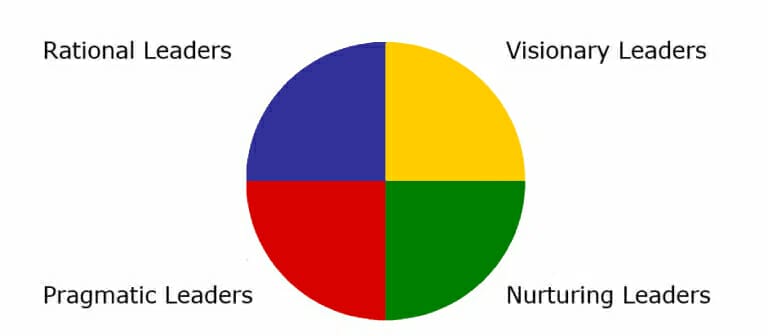
When Kasper Rorsted joined Adidas as CEO in 2016, the stock price soared. But by the time of his departure in November 2022, the stock price had fallen below its initial level. This must have been a disappointment for a leader who had always valued profitability.
Was the cause related to Rorsted’s leadership style – a hard-headed Blue Thinker within a company that thrives on creativity and emotion?
Let’s back up a bit. Leadership styles can be as diverse as the leaders themselves. They can broadly fall into four categories.

- Red Doers: the pragmatists, grounded in the here and now, favouring facts over theories, masters of operational detail.
- Yellow Intuitives: the visionaries, fixated on the future, forever pushing the boundaries of reality.
- Blue Thinkers: the rationalists, logic-driven, head-centred and masters of rules to organise things better.
- Green Feelers: the nurturers, heart-centred leaders who value harmony and the well-being of their teams above all else.
Rorsted is a quintessential Blue Thinker, celebrated for his emphasis on data-driven decision-making, clear goal-setting, and high accountability. The scene of his previous triumphs was Henkel, a German multinational dabbling in everything from adhesives to beauty care.
At Henkel, his love for numbers and lean processes turned the struggling company into an effective, profit-making machine. He was the ultimate profit-oriented CEO. A manager at Henkel described him as “clear, strong in leadership, and hardcore performance-oriented. Empathy and emotions were not his thing.”
But that was Henkel. Adidas was a different beast altogether.
Unlike Henkel, Adidas is a storytelling company, trading in emotional connections and thriving on brand-building. Not the best fit for Rorsted’s leadership style.
Rorsted could have demonstrated a better judgment of character and the ability to foster strong relationships. This stood out like a sore thumb during failed collaborations with high-profile celebrities like Kanye West and Beyoncé. Shareholders expecting significant returns on these investments were not amused, to say the least.
The lack of a universally appealing narrative under Rorsted’s reign further underscored this disconnect. Rorsted had handed over the “Global Brands” department to Brian Grevy and let him do as he pleased. It was a strategic mistake not to give brand management the full attention it deserved. A competitor’s manager went as far as to say, “Adidas is becoming irrelevant. Their stuff is no longer cool.”
The company’s crisis management under Rorsted also proved wanting. His compulsive need for structure and planning seemed unsuited to Adidas’ dynamic needs. A friend said of Rorsted, “He is a gifted strategist but not a crisis manager.”
At the start of the Ukrainian conflict, it became evident that Rorsted’s structured approach lacked the creativity and flexibility to manage crises. Adidas simply withdrew from the Russian market and wrote off its Russian business, much to its shareholders’ dismay.
The Chinese market presented another missed opportunity. Despite the aggressive expansion, Adidas failed to grasp the unique preferences of Chinese consumers. A more localized celebrity endorsement strategy was likely to have yielded better results.
The solution to Adidas’ leadership challenge has come in the form of Bjørn Gulden, the former CEO of its competitor Puma, who exhibits a Yellow Visionary leadership style characterized by a strong focus on innovation, collaboration, storytelling, customer orientation, and effective communication. So far, his appointment promises to reinvigorate Adidas. The stock price is up about 60% since his start.
The stark contrast between Rorsted and Gulden was on full display during a panel at the University of Nuremberg. When asked about their routines to maintain fitness, their responses painted vivid portraits of their disparate personalities. Rorsted, ever the disciplined strategist, mentioned his daily cycling to the Adidas campus and his predawn gym sessions, beginning at an hour when most people sleep. On the other hand, Gulden, with his easy-going charisma and quick wit, responded with a jest that his version of “fitness” involved leaving the pub at about the time Rosted went to the gym.
One embodied the essence of the rigid, regimented Blue Thinker; the other was a clear testament to the flexible, intuitive yellow persona.
The tales of Rorsted and Gulden serve as reminders of the importance of aligning leadership styles with an organization’s needs and culture. It’s not about good or bad leadership styles but finding the right fit for the role.
It is the same for FLOW based Project Management and Innovation. The best techniques come with new roles. The effectiveness of, for instance, a facilitator of stand-ups is a great deal determined by her/is personality type. An introverted Blue Thinker, for example, is usually not a good fit for this role. In contrast, an extraverted Yellow Intuitive revels in assessing issues, finding solutions, and motivating people to find ways to finish tasks in the best possible way.
In the near future, you can expect more blogs from us on roles in FLOW solutions and personality types that best fit them.
John van der Steur and Willem de Wit
June 2023
© copyright 2022 Mobilé 4 flow & innovation

Senior Advisor Team FLOW at Mobile 4 flow & innovation